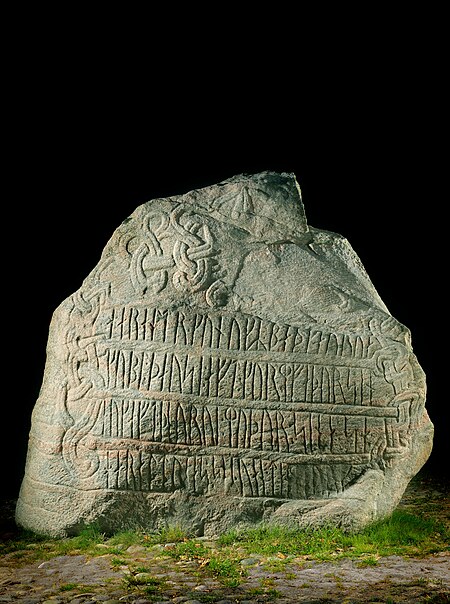Hello ladies and gents this is the Viking telling you that today we are talking about
Runestones
The Norse of the Viking Age could read and write and used a non-standardised alphabet, called runor, built upon sound values. While there are few remains of runic writing on paper from the Viking era, thousands of stones with runic inscriptions have been found where Vikings lived. They are usually in memory of the dead, though not necessarily placed at graves. The use of runor survived into the 15th century, used in parallel with the Latin alphabet.
The runestones are unevenly distributed in Scandinavia: Denmark has 250 runestones, Norway has 50 while Iceland has none. Sweden has as many as between 1,700 and 2,500 depending on definition. The Swedish district of Uppland has the highest concentration with as many as 1,196 inscriptions in stone, whereas Södermanland is second with 391.
The majority of runic inscriptions from the Viking period are found in Sweden. Many runestones in Scandinavia record the names of participants in Viking expeditions, such as the Kjula runestone that tells of extensive warfare in Western Europe and the Turinge Runestone, which tells of a war band in Eastern Europe.
Other runestones mention men who died on Viking expeditions. Among them include the England runestones (Swedish: Englandsstenarna) which is a group of about 30 runestones in Sweden which refer to Viking Age voyages to England. They constitute one of the largest groups of runestones that mention voyages to other countries, and they are comparable in number only to the approximately 30 Greece Runestones and the 26 Ingvar Runestones, the latter referring to a Viking expedition to the Middle East. They were engraved in Old Norse with the Younger Futhark.
The Jelling stones date from between 960 and 985. The older, smaller stone was raised by King Gorm the Old, the last pagan king of Denmark, as a memorial honouring Queen Thyre. The larger stone was raised by his son, Harald Bluetooth, to celebrate the conquest of Denmark and Norway and the conversion of the Danes to Christianity. It has three sides: one with an animal image, one with an image of the crucified Jesus Christ, and a third bearing the following inscription:
King Haraldr ordered this monument made in memory of Gormr, his father, and in memory of Thyrvé, his mother; that Haraldr who won for himself all of Denmark and Norway and made the Danes Christian.
Runestones attest to voyages to locations such as Bath,Greece (how the Vikings referred to the Byzantium territories generally), Khwaresm, Jerusalem, Italy (as Langobardland), Serkland (i.e. the Muslim world), England (including London), and various places in Eastern Europe. Viking Age inscriptions have also been discovered on the Manx runestones on the Isle of Man.
And as always have a chilled day from the Viking

Comments
Post a Comment